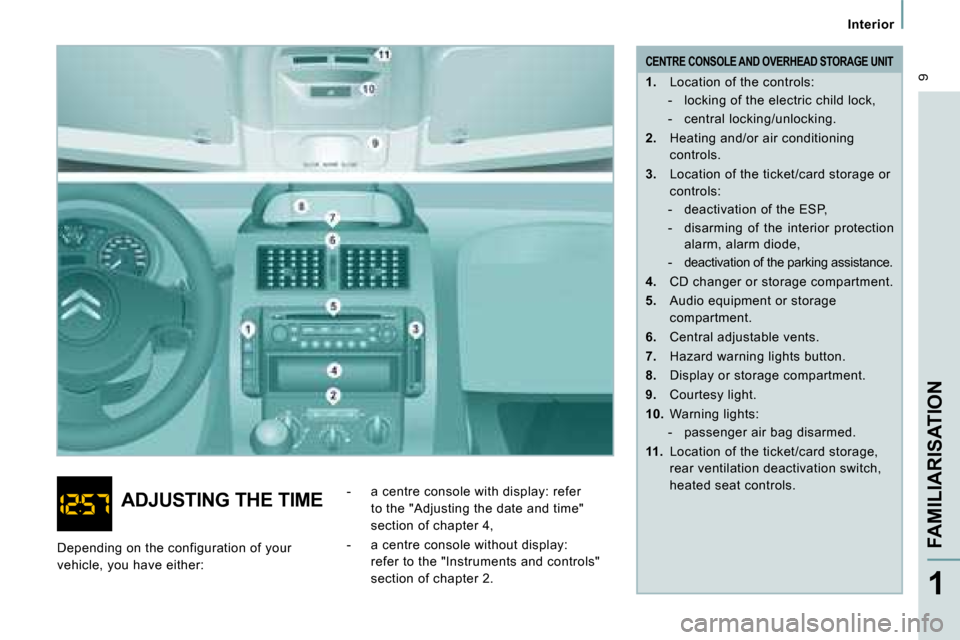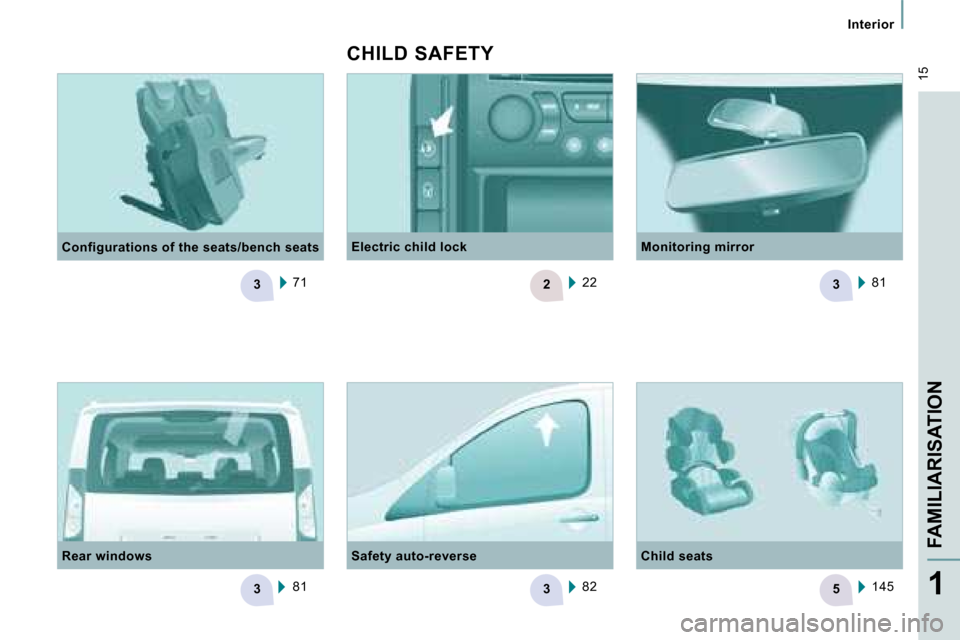child seat Citroen JUMPY MULTISPACE DAG 2008.5 2.G Owner's Manual
[x] Cancel search | Manufacturer: CITROEN, Model Year: 2008.5, Model line: JUMPY MULTISPACE DAG, Model: Citroen JUMPY MULTISPACE DAG 2008.5 2.GPages: 194, PDF Size: 6.92 MB
Page 6 of 194

9
FAMILIARISATION
1
CENTRE CONSOLE AND OVERHEAD STORAGE UNIT
1. Location of the controls:
- locking of the electric child lock,
- central locking/unlocking.
2. Heating and/or air conditioning
controls.
3. Location of the ticket/card storage or
controls:
- deactivation of the ESP,
- disarming of the interior protection alarm, alarm diode,
- deactivation of the parking assistance.
4. CD changer or storage compartment.
5. Audio equipment or storage
compartment.
6. Central adjustable vents.
7. Hazard warning lights button.
8. Display or storage compartment.
9. Courtesy light.
10. Warning lights:
- passenger air bag disarmed.
11. Location of the ticket/card storage,
rear ventilation deactivation switch,
heated seat controls.
ADJUSTING THE TIME - a centre console with display: refer to the "Adjusting the date and time"
section of chapter 4,
- a centre console without display: refer to the "Instruments and controls"
section of chapter 2.
Depending on the configuration of your
vehicle, you have either:
Interior
Page 12 of 194

3
33
23
5
15
FAMILIARISATION
1
71
Configurations of the seats/bench seats
81
Rear windows
Safety auto-reverse
82
Electric child lock
22
CHILD SAFETY
Monitoring mirror 81
Child seats 145
Interior
Page 28 of 194

28
Instruments and controls
Warning light is indicates Solution - action
Front/side/
curtain air bag flashing or
remaining on.
failure of an air bag. Have the system checked by a CITROËN dealer with
out
delay. Chapter 5, "Air bags" section.
Front
passenger air
bag disarmed lit. intentional disarming of this air
bag in the presence of a rear
facing child seat. Chapter 5, "Air bags-children on board" section.
Low fuel level lit with gauge
needle in the red
zone.
fuel reserve being used. Fill up with fuel without delay. The evaluation of
the fuel
reserve is a parameter which is sensitive to the style of
�d�r�i�v�i�n�g�,� �t�h�e� �p�r�o�fi� �l�e� �o�f� �t�h�e� �r�o�a�d�,� �t�h�e� �t�i�m�e� �e�l�a�p�s�e�d� �a�n�d� �t�h �e�
distance travelled from the time the warning light comes on.
flashing. cutting off of the supply
following a serious impact. Restore the supply. Chapter 7, "Fuel" section.
EOBD emission
control system flashing or
remaining on.
failure of the system. Have the system checked by a CITROËN dealer as s
oon
as possible.
Battery charge lit. fault in the charging circuit.
Check the battery terminals, … Chapter 8, "Battery
"
section.
flashing. placing of the active functions
on standby (economy mode). Chapter 8, "Battery" section.
remaining on,
in spite of the
checks. faulty circuit, injection or ignition
malfunction.
Call a CITROËN dealer.
Page 139 of 194

139
Seat belts
SAFETY
5
The force limiter reduces the pressure of the
seat belt against the body of the occupants.
The pretensioning seat belts are active
when the ignition is switched on.
The inertia reels are fitted with a device
which automatically locks the strap in the
event of a collision or emergency braking or
if the vehicle rolls over.
You can unfasten the seat belt by pressing
the red button on the buckle. Guide the seat
belt after unfastening.
The air bag warning light comes on if the
pretensioners are triggered.
Consult a CITROËN dealer. Recommendations for children:
- use a suitable child seat if the
passenger is less than 12 years old or
shorter than one metre fifty,
- never allow a child to travel on your lap, even with the seat belt fastened. FRONT SEAT BELTS
REAR SEAT BELTS
If your vehicle is fitted with an individual seat
and a 2-seat bench, the 3 seats are fitted
with three-point seat belts and inertia reels.
The centre seat has its seat belt guide and
inertia reel integrated with the seat back.
For further information regarding child
seats, refer to the "Children on board"
section of chapter 5.
In accordance with current safety
regulations, your CITROËN dealer
guarantees all work or any checks, from
testing to maintenance, on your seat belt
equipment.
Have the seat belts checked regularly
(even after a minor impact) by a CITROËN
dealer: they must not show any signs of
wear, cutting or fraying and they must not be
transformed or modified.
Clean the seat belt straps with soapy
water or a textile cleaning product, sold
by CITROËN dealers.
In order to be effective, a seat belt must:
- restrain one person only,
- must not be twisted, check by pulling in
front of you with an even movement,
- be tightened as close to the body as possible.
The upper part of the seat belt should be
positioned in the hollow of the shoulder.
The lap part should be placed as low as
possible on the pelvis.
Do not invert the seat belt buckles as they
will not fulfil their role completely. If the
seats are fitted with armrests, the lap part of
the seat belt should always pass under the
armrest.
Check that the seat belt is fastened correctly
by pulling the strap firmly.
The front seats are fitted with pretensioners
and force limiters.
Without front air bag
If your vehicle is fitted with a front bench
without front air bag, the centre passenger's
seat belt does not have a pretensioner.
In rows 2 and 3, take care to fasten the
correct seat belt in the correct buckle. Do not
invert the seat belt or the buckle of the side
seats with the buckle or the seat belt of the
centre seat.
Page 140 of 194

141
Air bags
SAFETY
5
The air bags have been designed to
maximise the safety of the occupants (with
the exception of the centre seats of rows
2 and 3) in the event of a serious collision;
they work in conjunction with the force
limiting seat belts.
In the event of a serious collision, the
electronic detectors record and analyse the
front and side impacts suffered in the impact
detection zones:
- in the event of a serious impact, the air bags inflate instantly and protect the
occupants of the vehicle. Immediately after the impact, the air bags
deflate rapidly, so that they do not hinder the
visibility of the occupants nor their possible
exit from the vehicle.
- in the event of a minor or rear impact
and in certain roll-over conditions,
the air bags will not be deployed; the
seat belt alone is sufficient to provide
maximum protection in these situations.
The seriousness of the collision depends on
the nature of the obstacle and the speed of
the vehicle at the moment of impact. It is imperative that the passenger
air bag is disarmed if a child seat is
installed facing rearwards. Refer to the
"Children on board" section of chapter 5. Air bags only operate when the
ignition is switched on.
This equipment only operates once. If a
second impact occurs (during the same or
a subsequent accident), the air bag will not
operate.
The triggering of an air bag or air bags
is accompanied by a slight discharge of
harmless smoke and a noise, due to the
activation of the pyrotechnic cartridge
incorporated in the system.
This smoke is not harmful, but sensitive
individuals may experience some irritation.
The noise of the detonation may result in a
slight loss of hearing for a short time.
AIR BAGS
Page 141 of 194

142
Air bags
Good practice
Sit in a normal upright position.
Wear a correctly adjusted seat belt.
Do not leave anything between the
occupants and the air bags (a child, pet,
object...). This could hamper the operation
of the air bags or injure the occupants.
After an accident or if the vehicle has been
stolen or broken into, have the air bag
systems checked.
All work on the air bag system is strictly
forbidden unless it is carried out by qualified
personnel of the CITROËN network. Side air bags
Only put recommended covers on the seats.
These will not hinder inflation of the side air
bags. Consult a CITROËN dealer.
Do not fix or glue anything to the seat backs.
This could cause injury to the chest or arms
when the side air bag inflates.
Do not sit with the upper part of the body
any nearer to the door than necessary.
Front air bags
Do not drive holding the steering wheel
by its spokes or resting your hands on the
centre part of the wheel.
Do not allow passengers to place their feet
on the fascia, they risk serious injury if the
air bag is triggered.
Smoke as little as possible as deployment of
the air bags can cause burns or the risk of
injury from a cigarette or pipe.
Never remove or pierce the steering wheel
or hit it violently.
Even if all of the precautions mentioned are
observed, a risk of injury or of minor burns
to the head, chest or arms when an air bag
is triggered cannot be ruled out. In fact, the
bag inflates almost instantly (within a few
milliseconds) then deflates within the same
time discharging the hot gas via openings
provided for this purpose. Curtain air bags
Do not fix or glue anything to the roof. This
could cause injury to the head when the
curtain air bag inflates.
Do not remove the grab handles installed
on the roof, they play a part in securing the
curtain air bags.
Page 142 of 194

144
Air bags
Disarming
The passenger's front air bag alone can be
disarmed:
- With the ignition switched off, insert
the key into the passenger air bag
disarming switch,
- turn it to the "OFF" position,
- then remove the key keeping the slot in this position. Front air bags
The front air bags are incorporated in the
centre of the steering wheel for the driver
and in the fascia for the front passenger. Reactivation
In the
"OFF" position, the passenger air
bag will not be triggered in the event of an
impact.
As soon as the child seat is removed, turn the
air bag slot to the "ON" position to re-activate
the air bag and thus ensure the safety of your
passenger in the event of an impact. To ensure the safety of your child, it
is essential to disarm the passenger
air bag when you install a rear-facing child
seat on the front passenger seat. Otherwise,
the child would risk being killed or seriously
injured if the air bag were to inflate.
The air bag warning light on the
instrument panel is lit throughout
the period of disarming.
Activation
They are deployed simultaneously, unless
the passenger's front air bag has been
disarmed, in the event of a serious front
impact applied to all or part of the front
impact zone
A in the longitudinal centreline
of the vehicle on a horizontal plane directed
from the front towards the rear of the vehicle.
The front air bag inflates between the front
occupant of the vehicle and the fascia to
cushion his forward movement. Front air bag fault
If this warning light comes on,
accompanied by an audible signal
and a message on the display,
contact a CITROËN dealer to
have the system checked.
If the two air bag warning lights are lit
continuously, do not install a rear-facing
child seat. Consult a CITROËN dealer.
Page 143 of 194

141
Air bags
SAFETY
5
The air bags have been designed to
maximise the safety of the occupants (with
the exception of the centre seats of rows
2 and 3) in the event of a serious collision;
they work in conjunction with the force
limiting seat belts.
In the event of a serious collision, the
electronic detectors record and analyse the
front and side impacts suffered in the impact
detection zones:
- in the event of a serious impact, the air bags inflate instantly and protect the
occupants of the vehicle. Immediately after the impact, the air bags
deflate rapidly, so that they do not hinder the
visibility of the occupants nor their possible
exit from the vehicle.
- in the event of a minor or rear impact
and in certain roll-over conditions,
the air bags will not be deployed; the
seat belt alone is sufficient to provide
maximum protection in these situations.
The seriousness of the collision depends on
the nature of the obstacle and the speed of
the vehicle at the moment of impact. It is imperative that the passenger
air bag is disarmed if a child seat is
installed facing rearwards. Refer to the
"Children on board" section of chapter 5. Air bags only operate when the
ignition is switched on.
This equipment only operates once. If a
second impact occurs (during the same or
a subsequent accident), the air bag will not
operate.
The triggering of an air bag or air bags
is accompanied by a slight discharge of
harmless smoke and a noise, due to the
activation of the pyrotechnic cartridge
incorporated in the system.
This smoke is not harmful, but sensitive
individuals may experience some irritation.
The noise of the detonation may result in a
slight loss of hearing for a short time.
AIR BAGS
Page 144 of 194

142
Air bags
Good practice
Sit in a normal upright position.
Wear a correctly adjusted seat belt.
Do not leave anything between the
occupants and the air bags (a child, pet,
object...). This could hamper the operation
of the air bags or injure the occupants.
After an accident or if the vehicle has been
stolen or broken into, have the air bag
systems checked.
All work on the air bag system is strictly
forbidden unless it is carried out by qualified
personnel of the CITROËN network. Side air bags
Only put recommended covers on the seats.
These will not hinder inflation of the side air
bags. Consult a CITROËN dealer.
Do not fix or glue anything to the seat backs.
This could cause injury to the chest or arms
when the side air bag inflates.
Do not sit with the upper part of the body
any nearer to the door than necessary.
Front air bags
Do not drive holding the steering wheel
by its spokes or resting your hands on the
centre part of the wheel.
Do not allow passengers to place their feet
on the fascia, they risk serious injury if the
air bag is triggered.
Smoke as little as possible as deployment of
the air bags can cause burns or the risk of
injury from a cigarette or pipe.
Never remove or pierce the steering wheel
or hit it violently.
Even if all of the precautions mentioned are
observed, a risk of injury or of minor burns
to the head, chest or arms when an air bag
is triggered cannot be ruled out. In fact, the
bag inflates almost instantly (within a few
milliseconds) then deflates within the same
time discharging the hot gas via openings
provided for this purpose. Curtain air bags
Do not fix or glue anything to the roof. This
could cause injury to the head when the
curtain air bag inflates.
Do not remove the grab handles installed
on the roof, they play a part in securing the
curtain air bags.
Page 146 of 194

145
Child safety
SAFETY
5
CHILD SAFETY
GENERAL POINTS RELATING TO CHILD SEATS
Although one of CITROËN main criteria
when designing your vehicle, the safety of
your children also depends on you.
For maximum safety, please follow these
precautions:
- all children under the age of 12 or less than one metre fifty tall must travel in
approved child seats suited to their
weight, on seats fitted with a seat belt or
ISOFIX mountings.
- statistically, the safest seats in your vehicle for the transportation of children
are the rear seats,
- a child weighing less than 9 kg must travel in the "rearwards-facing" position
both in the front and in the rear.
"Rearwards-facing"
When a "rearwards-facing" child seat is
installed on the front passenger seat, it
is essential that the passenger air bag is
disarmed. Otherwise, the child would risk
being seriously injured or killed if the air bag
were to inflate.
"Forwards-facing"
When a "forwards-facing" child seat is
installed on the front passenger seat, leave
the passenger air bag armed.
INSTALLING A CHILD SEAT USING A THREE POINT SEAT B ELT
The rules for transporting children are
specific to each country. Consult the current
legislation in your country.
Please consult the list of seats approved
in your country. The isofix mountings, the
rear seats, the passenger air bag and the
disarming of this air bag depend on the
version sold.
CITROËN recommends that children should
travel in the rear seats of your vehicle :
- "rearwards-facing" up to the age of 2,
- "forwards-facing" over the age of 2.